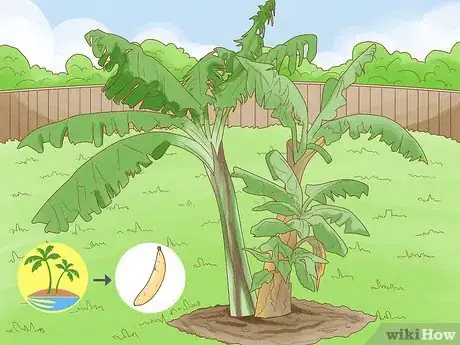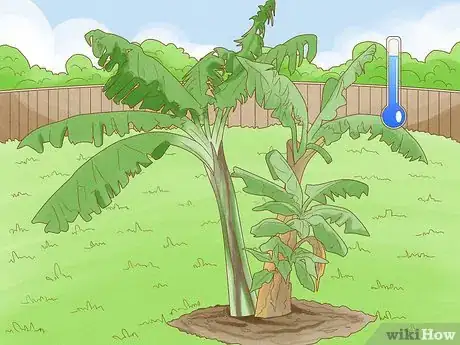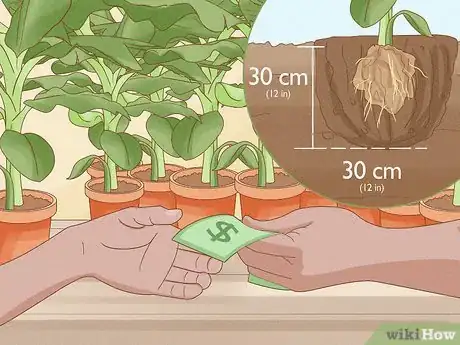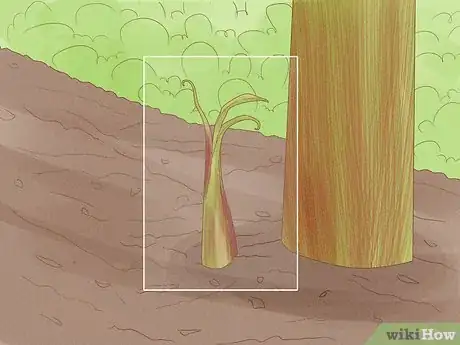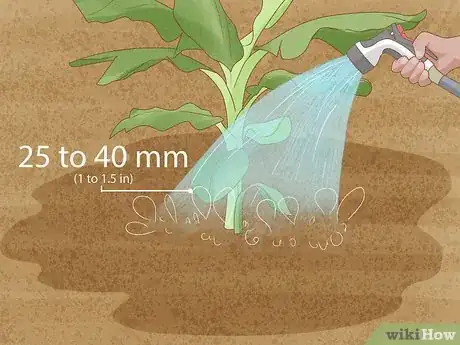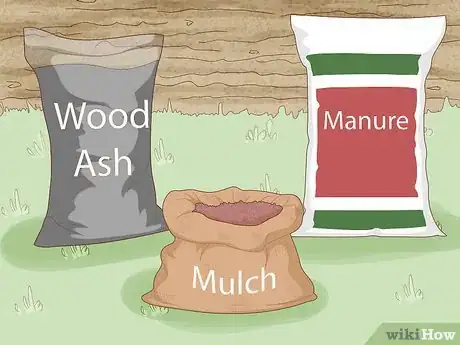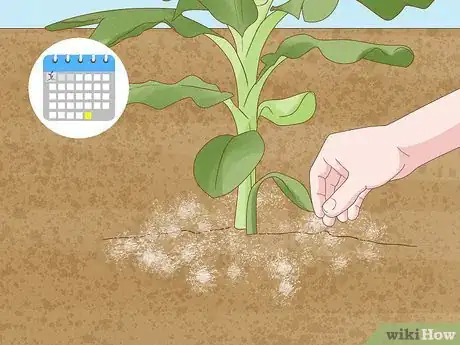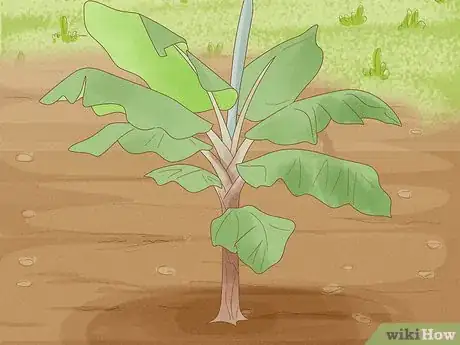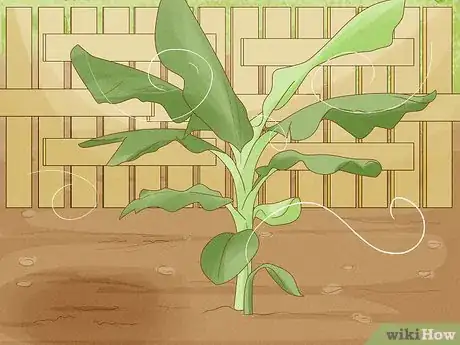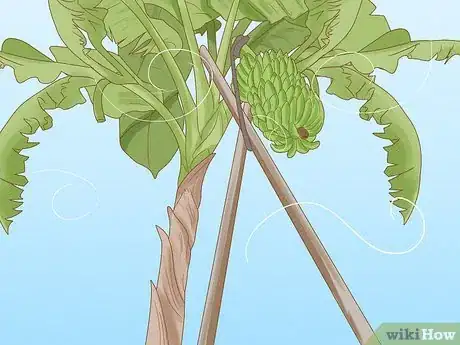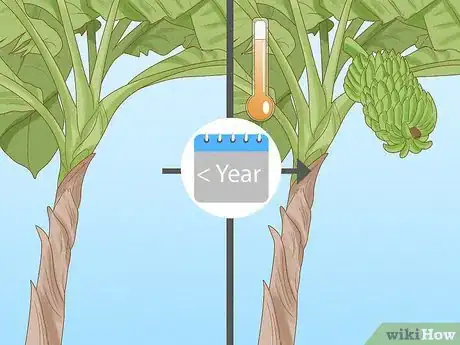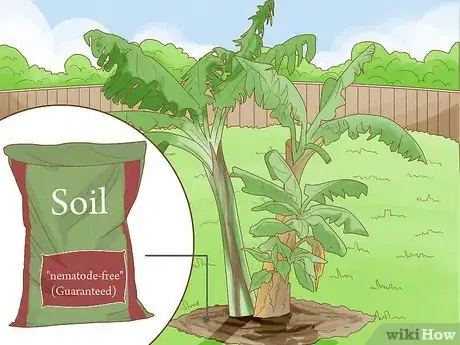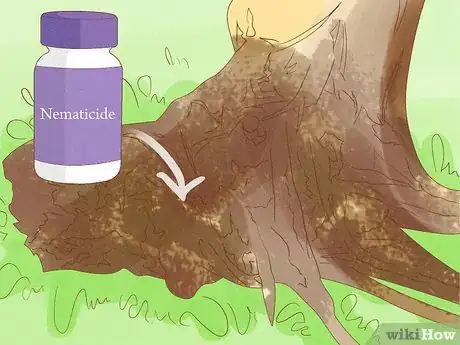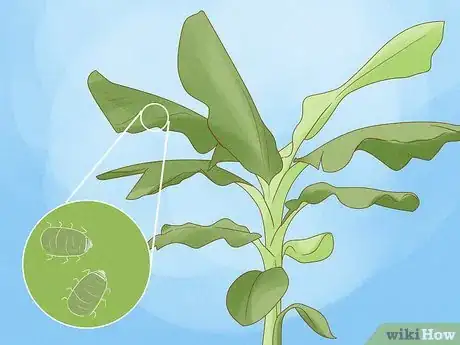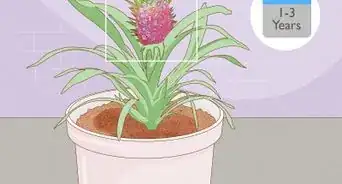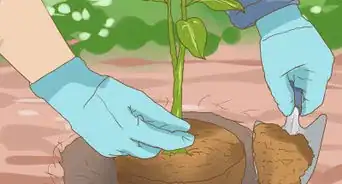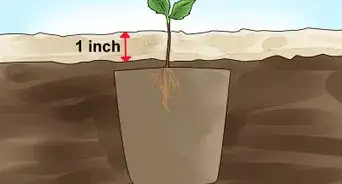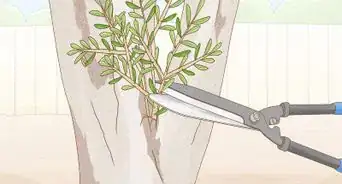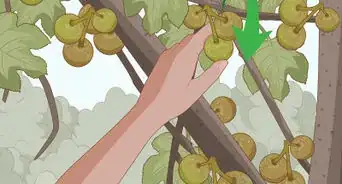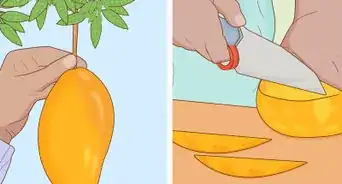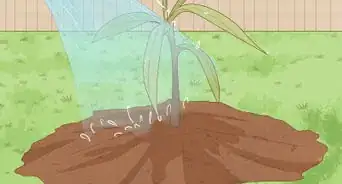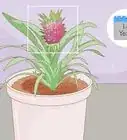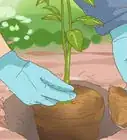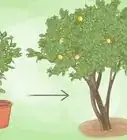This article was co-authored by wikiHow Staff. Our trained team of editors and researchers validate articles for accuracy and comprehensiveness. wikiHow's Content Management Team carefully monitors the work from our editorial staff to ensure that each article is backed by trusted research and meets our high quality standards.
There are 14 references cited in this article, which can be found at the bottom of the page.
This article has been viewed 14,096 times.
Learn more...
Plantains and bananas (which are just different varieties of the same species) may grow into tall, tree-sized plants, but the whole thing is actually an herb without a true trunk or deep root system.[1] This makes their planting and care a bit different from actual fruit trees, but it's nothing a moderately experienced gardener (or even a dedicated novice) can't handle. One point to be aware of: unless you live fairly close to the equator, your plantain plant will probably not make any fruit. In that case, you'll have to settle for a beautiful tropical ornament instead.
Steps
What climate do you need to grow plantains?
-
1Plantains need tropical weather to fruit. In their native habitat, plantains are used to 100 millimetres (3.9 in) of water per month and temperatures around 30 °C (86 °F).[2] For them to fruit reliably, they'll need tropical conditions like this almost year-round.[3] In subtropical climates like Florida or most of Australia, you might get plantains to fruit with careful management and plenty of water.
- In the tropics, you can plant plantains anytime there are at least three months left in the rainy season.[4]
-
2You can grow plantains as ornamental plants in cooler climates. They're surprisingly hardy for tropical plants, so as long as you don't mind the lack of fruit, you can still plant them outside the tropics. Warm growing seasons and mild winters are still best for fast growth.[5]
- Mild frost will kill the leaves, while anything colder will cause it to die back to the ground (and grow again in spring).[6] Below -7ºC (20ºF), plantains need heavy winter protection: burlap wrapping, thick root mulch, and an enclosure filled with at least 1 m (3 ft.) of dry leaves. Below about -12ºC (10ºF), they won't survive outdoors.[7]
- Outside of the tropics, plant plantains when there are at least three months left of warm weather.
How do you plant a plantain tree?
-
1Plant nursery-bought plantains in a hole with topsoil at the base. Dig a hole 30 centimetres (12 in) across and at least 30 centimetres (12 in) deep. (60 centimetres (24 in) is even better if you can manage it.[10] ) Put the root ball of the plantain into this hole, then fill the area around the roots with high-quality topsoil. Fill the rest of the hole with the lower-quality soil originally from the bottom of the hole.[11]
- Plant nurseries also sell tiny, container-grown suckers from a plant nursery. These are more fragile in the first couple months, but can work out great if they survive.[12] You don't need a large hole for these—just transplant them so they're at the same soil depth they were in the container.
-
2Or prep your own "sucker" from another plant. Plantains are propagated from pieces of the mother plant, not grown from seed. So if you know someone with a plantain tree, you can use it to get your own young plantain:
- Choose a sucker (a growth at the base of the mother plant) at least 30 cm (12 in) tall, and ideally 50 cm (20 in) tall and 15 cm (6 in) across.[13] The ones with long, blade-like leaves are best for fruit.[14] The ones with broader leaves are stronger, but won't bear fruit.[15]
- Disinfect your tools, then dig up the sucker's bulb-like base (the "corm").[16] Try to cut it away from the mother plant with a single stroke of a machete or sharp shovel, and cut as close to the mother plant as you can.[17]
- Peel off the outer layer of the corm with a sharp, disinfected knife, starting where the outer layer of leaves attach and peeling all the way down to remove the roots.[18] Anything that isn't pure white is infected, so cut that away as well.[19]
- Plant in a hole 30 centimetres (12 in) or deeper, as described above.
What is the best way to fertilize plantains?
-
1Mulch, manure, or wood ash are excellent for plantains. Cover the soil around the plantain plant with one of these organic fertilizers in a circle about 50 centimetres (20 in) across. In addition to fertilizing, this layer traps moisture, stops weeds from growing, and encourages helpful soil microbes.[24]
- Mixing it into the soil is not necessary and can even damage the root network. Save yourself the effort and just leave it on top.[25]
-
2Potassium is the most important nutrient, then nitrogen. If you use an inorganic fertilizer product instead of mulch, choose one extra high in potassium. Plantains often need twice as much potassium as nitrogen to produce a good amount of fruit.[26] (This is a bit less important if you are growing them ornamentally, but potassium still helps with growth.)
- For example, a fertilizer labeled "3-1-6" is a good choice.[27] This "N-P-K" number refers to the ratio of nitrogen, phosphorus, and potassium in that order.
- You could instead buy potassium supplements to add along with your mulch or to a balanced fertilizer.
-
3Fertilize one month after planting, then throughout the growing season. Plantains tend to need multiple doses a year, but the exact amount depends on the quality of your soil and how quickly it drains.[28] When in doubt, try four times a year, spaced evenly throughout the growing season.[29]
- Plantains don't have a natural dormant period like most non-tropical plants. They'll grow any time they have plenty of water and warm weather.
How do you protect plantains from wind?
-
1Choose dwarf varieties for better wind resistance. If you live in a windy area, try a dwarf variety like "Dwarf Puerto Rican" or "Goroho." These grow shorter and thicker, so they're less likely to tip over.[30] Even the "dwarf" varieties can easily grow to 2 meters (6.5 ft) and sometimes even higher, so you don't need to settle for a miniature plant.[31]
-
2Provide a wind break for young plantains. Plantains don't have deep roots and can easily tip over in the first few months after planting. If you can, plant them in a spot where buildings, trees, or fences block the prevailing winds in your area. A temporary screen or fence can also work well. The best windbreak has gaps or holes to let some of the wind through, instead of redirecting it with full force around the fence.[32]
-
3Prop up adult plantains when needed. Adult plantains are most vulnerable to wind while they have fruit, as well as in dry weather. At these times, if you expect high winds, it helps to put a tall stake in the ground (bamboo works well) and tie it to the top of the plantain. Alternatively, tie two crossed stakes together to make a fork, and rest the heavy plantain bunch at the intersection.[36]
How do you protect plantains from disease?
-
1Try to keep new soil additions infection-free. The best way to handle plant diseases is to prevent them in the first place. When adding new topsoil to your garden, look for a "nematode-free" guarantee. Composting and mulching can also help keep your garden soil healthy, as long as those materials didn't come from an infected source.[41] (For instance, you wouldn't want to put discolored or rotted leaves back into your compost heap unless you have a heat treatment system to disinfect it.)
- Be especially careful bringing new plantains and bananas into the garden. Cut away any odd-colored patches on their base before planting, and don't throw away the cut material into your garden.[42]
-
2Apply nematocide if you see root damage. Some of the most common plantain pests are nematodes, or tiny soil worms. Some types cause brown or black lesions on the roots and base of the plant, while others cause roots to swell and crack.[43] If you see this, buy a "nematicide" from a plant nursery and apply it in a circle 25 centimetres (9.8 in) across around the plantain. Repeat three times per year to keep the infection under control.[44]
- If your plantain seems loose from the soil and easily tips over, this could be caused by root damage.[45]
-
3Look out for aphids and other insects. Aphids are widespread, and their infestations can also lead to viral and fungal infections.[46] Deal with them quickly with soap sprays, ladybugs, or pesticides when you see these small insects on the leaves, or their sticky secretions.
- Other insect pests vary depending on your location. Bring a photograph to your local plant nursery or agricultural extension to get advice on treating local pests.
Warnings
- Grasses and other weeds can compete with plantains, which don't have a deep root system like true trees. Mulch is the best weed control option, since weeding by hand or using herbicides risks damaging the plantain roots.[51]⧼thumbs_response⧽
References
- ↑ https://edis.ifas.ufl.edu/publication/mg040
- ↑ http://newint.iita.org/wp-content/uploads/2016/05/Plantain-cultivation-under-West-African-conditions-a-reference-manual.pdf
- ↑ https://www.missouribotanicalgarden.org/PlantFinder/PlantFinderDetails.aspx?taxonid=251225&isprofile=0&
- ↑ http://newint.iita.org/wp-content/uploads/2016/05/Plantain-cultivation-under-West-African-conditions-a-reference-manual.pdf
- ↑ https://edis.ifas.ufl.edu/publication/ST409
- ↑ https://aggie-horticulture.tamu.edu/fruit-nut/fact-sheets/banana/
- ↑ https://www.missouribotanicalgarden.org/PlantFinder/PlantFinderDetails.aspx?taxonid=251225&isprofile=0&
- ↑ https://edis.ifas.ufl.edu/publication/mg040
- ↑ https://bch.cbd.int/database/attachment/?id=12529
- ↑ https://edis.ifas.ufl.edu/publication/mg040
- ↑ http://newint.iita.org/wp-content/uploads/2016/05/Plantain-cultivation-under-West-African-conditions-a-reference-manual.pdf
- ↑ https://www.degruyter.com/document/doi/10.1515/opag-2018-0014/pdf
- ↑ https://bch.cbd.int/database/attachment/?id=12529
- ↑ http://newint.iita.org/wp-content/uploads/2016/05/Plantain-cultivation-under-West-African-conditions-a-reference-manual.pdf
- ↑ https://www.degruyter.com/document/doi/10.1515/opag-2018-0014/pdf
- ↑ http://newint.iita.org/wp-content/uploads/2016/05/Plantain-cultivation-under-West-African-conditions-a-reference-manual.pdf
- ↑ https://www.echocommunity.org/en/resources/81df8839-121f-41ae-a746-2e48e4fc165f
- ↑ https://www.echocommunity.org/en/resources/81df8839-121f-41ae-a746-2e48e4fc165f
- ↑ http://newint.iita.org/wp-content/uploads/2016/05/Plantain-cultivation-under-West-African-conditions-a-reference-manual.pdf
- ↑ https://www.cambridge.org/core/journals/experimental-agriculture/article/abs/water-relations-and-irrigation-requirements-of-banana-musa-spp/05891D7F8A34F0D4F2D9726ECFA500E7
- ↑ https://edis.ifas.ufl.edu/publication/mg040
- ↑ https://www.cambridge.org/core/journals/experimental-agriculture/article/abs/water-relations-and-irrigation-requirements-of-banana-musa-spp/05891D7F8A34F0D4F2D9726ECFA500E7
- ↑ https://edis.ifas.ufl.edu/publication/mg040
- ↑ http://newint.iita.org/wp-content/uploads/2016/05/Plantain-cultivation-under-West-African-conditions-a-reference-manual.pdf
- ↑ http://newint.iita.org/wp-content/uploads/2016/05/Plantain-cultivation-under-West-African-conditions-a-reference-manual.pdf
- ↑ https://www.researchgate.net/publication/273466722_Nitrogen_and_potassium_fertilizer_influenced_nutrient_use_efficiency_and_biomass_yield_of_two_plantain_Musa_spp_AAB_genotypes
- ↑ https://edis.ifas.ufl.edu/publication/mg040
- ↑ http://newint.iita.org/wp-content/uploads/2016/05/Plantain-cultivation-under-West-African-conditions-a-reference-manual.pdf
- ↑ https://www.abc.net.au/gardening/factsheets/growing-bananas/9428562
- ↑ https://bch.cbd.int/database/attachment/?id=12529
- ↑ https://www.e3s-conferences.org/articles/e3sconf/pdf/2021/08/e3sconf_iconard2020_03007.pdf
- ↑ https://www.rhs.org.uk/advice/profile?pid=624
- ↑ https://plantvillage.psu.edu/topics/plantain/infos
- ↑ https://bch.cbd.int/database/attachment/?id=12529
- ↑ https://bch.cbd.int/database/attachment/?id=12529
- ↑ http://newint.iita.org/wp-content/uploads/2016/05/Plantain-cultivation-under-West-African-conditions-a-reference-manual.pdf
- ↑ https://bch.cbd.int/database/attachment/?id=12529
- ↑ http://newint.iita.org/wp-content/uploads/2016/05/Plantain-cultivation-under-West-African-conditions-a-reference-manual.pdf
- ↑ https://edis.ifas.ufl.edu/publication/mg040
- ↑ https://www.missouribotanicalgarden.org/PlantFinder/PlantFinderDetails.aspx?taxonid=251225&isprofile=0&
- ↑ https://bch.cbd.int/database/attachment/?id=12529
- ↑ http://newint.iita.org/wp-content/uploads/2016/05/Plantain-cultivation-under-West-African-conditions-a-reference-manual.pdf
- ↑ https://bch.cbd.int/database/attachment/?id=12529
- ↑ http://newint.iita.org/wp-content/uploads/2016/05/Plantain-cultivation-under-West-African-conditions-a-reference-manual.pdf
- ↑ https://bch.cbd.int/database/attachment/?id=12529
- ↑ https://bch.cbd.int/database/attachment/?id=12529
- ↑ https://bch.cbd.int/database/attachment/?id=12529
- ↑ http://newint.iita.org/wp-content/uploads/2016/05/Plantain-cultivation-under-West-African-conditions-a-reference-manual.pdf
- ↑ https://edis.ifas.ufl.edu/publication/mg040
- ↑ https://www.degruyter.com/document/doi/10.1515/opag-2018-0014/pdf
- ↑ http://newint.iita.org/wp-content/uploads/2016/05/Plantain-cultivation-under-West-African-conditions-a-reference-manual.pdf
